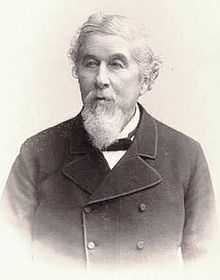John Bard

John Bard (1819-1899) was a Christian philanthropist. He and his wife, Margaret Johnston, founded Bard College in New York, which was then known as St. Stephen's College, in order to train Episcopal Church ministers.
Life and work
John Bard was born in Hyde Park, New York in 1819 as the eleventh of fourteen children.[1] Bard was descended from a family of physicians and professors. His father, William Bard, was an attorney who was a pioneer in life insurance in this country. John Bard was also the grandson of Samuel Bard, a prominent doctor, a founder of Columbia University's medical school, and physician to George Washington.[2] John Bard was also the nephew of the Rev. John McVickar, a professor at Columbia University. The family had strong connections with the Episcopal Church and Columbia. Bard worked as president of the New York Life Insurance and Trust Company.
Bard was a devout Christian and wanted to help improve the quality of life of the poor and to encourage more minsters to be trained. In 1849 he married Margaret Taylor Johnston who held similar beliefs and in 1853 they purchased a part of the Blithewood estate and renamed it Annandale. Margaret Bard's father was a founder of New York University. The Bards were committed to many educational projects in their community and other nearby neighborhoods.[3] In 1854, John and Margaret established a parish school on their estate in order to educate the area's children with a small building Bard Hall, serving as a school on weekdays and a chapel on weekends. In 1857, the Bards expanded the parish by building the Chapel of the Holy Innocents next to Bard Hall.[4] During this time, John Bard remained in close contact with the New York leaders of the Episcopal Church. The Church suggested that he found a theological college.[5] The Bards also collaborated with James Starr Clark from Tivoli to found the Trinity Church and School, and also Trinity Academy, a school for young boys.[6]
With the promise of outside financial support, John Bard donated the unfinished Chapel, and the surrounding 18 acres, to the diocese in November 1858. In March 1860, St. Stephen's College was founded. In 1861, construction began on the first St. Stephen's College building, a stone collegiate gothic dormitory called Aspinwall.[7] After the Bards' only son Willie died in 1868, the Bards and their three daughters moved to Europe, and[8] Margaret Bard died in 1875. John Bard died in 1899 but remained involved with the institutions he helped found until his death.[9] He is buried in the Bard cemetery.[10] St. Stephen's College officially changed its name to Bard College in 1934 in honor of its founder.[11]
References
- ↑ http://www.hvmag.com/core/pagetools.php?pageid=8258&url=%2FHudson-Valley-Magazine%2FMarch-2011%2FBard-College-A-150-Year-History%2F&mode=print
- ↑ Hirsch, Felix (October 1941). "The Bard Family". Columbia University Quarterly (Bard College Archives, Annandale-on-Hudson, NY).
- ↑ http://www.bard.edu/bardinblackandwhite/page3.html
- ↑ Kline, Reamer (1982). Education for the Common Good: A History of Bard College The First 100 Years, 1860-1960. Annandale-on-Hudson, NY: Bard College. p. 15.
- ↑ Hopson, George (1910). Reminiscences of St. Stephen’s College. New York, NY: Edwin S. Gorham. pp. 16–17.
- ↑ http://www.hrvh.org/cdm/singleitem/collection/bard/id/166/rec/7
- ↑ Magee, Christopher (1950). The History of St. Stephen’s College 1860-1933. Annandale-on-Hudson, NY: Bard College Senior Project. p. 38.
- ↑ http://www.hrvh.org/cdm/singleitem/collection/bard/id/166/rec/7
- ↑ http://www.hrvh.org/cdm/singleitem/collection/bard/id/166/rec/7
- ↑ http://www.hrvh.org/cdm/singleitem/collection/bard/id/166/rec/7
- ↑ http://www.hrvh.org/cdm/singleitem/collection/bard/id/166/rec/7